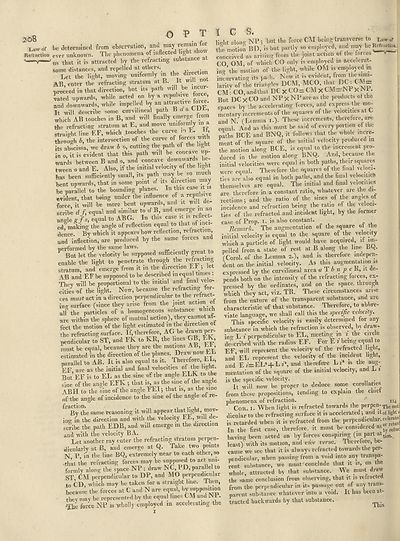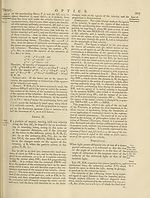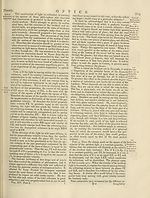Encyclopaedia Britannica > Volume 15, NIC-PAR
(228) Page 208
Download files
Complete book:
Individual page:
Thumbnail gallery: Grid view | List view

OPT
l»c determined from observation, ana may lemain for
ever unknown. The phenomena of inflected light *how
us that it is attracted by the refracting substance at
some distances, and repelled at others.
Let the light, moving uniformly in the direction
AB, enter the refracting stratum at B. It wll not
proceed in that direction, but its path will be incur¬
red upwards, while acted on by a repulsive force,
and downwards, while impelled by an attractive for .
It will describe some curvilmeal path n a a
which AB touches in B, and will finally emerge from
the refracting stratum at E, and move uniformly m a
straight line EF, which touches the curve m E. It
through b, the intersection of the curve of forces ™th
its abscissa, we draw b o, cutting the path of the light
in o, it is evident that this path will be concave up¬
wards between B and o, and concave downwards be¬
tween o and E. Also, if the initial velocity of the light
has been sufficiently small, its path may be so much
bent upwards, that in some point d its direction may
be parallel to the bounding planes. In this case it is
evident, that being under the influence of a repulsne
force, it will he more bent upwards, and it will de¬
scribe d f, equal and similar to d B, and emerge m an
Ingle fs, equal to ABG. In this case it is reflect-
edf making the angle of reflection equal to that of inci¬
dence. By which it appears how reflection, refraction,
and inflection, are produced by the same forces an
performed by the same laws.
But let the velocity be supposed sufficiently great to
enable the light to penetrate through the refracting
stratum, and emerge from it in the direction L , e
AB and EF be supposed to he described in equal times :
They will he pronortional to the initial and final velo¬
cities of the light. Now, because the refracting for¬
ces must act in a direction perpendicular to the retract¬
ing surface (since they arise from the joint action ot
alf the particles of a homogeneous substance w.uch
are within the sphere of mutual action), they cannot at-
fect the motion of the light estimated in the direction ot
the refracting surface. If therefore, AG be drawn per¬
pendicular to ST, and FK to Kll, the lines GB, EK,
must be equal, because they are the motions AB, Ei ,
estimated in the direction of the planes. Draw now EE
parallel to AB. It is also equal to it._ Therefore, EL,
EF are as the initial and final velocities of the light.
Bu^EF is to EL as the sine of the angle ELK to the
sine of the angle EFK ; that is, as the sine of the angle
ABH to the sine of the angle FEIj that is, as the sine
of the angle of incidence to the sine of the angle ot re¬
fraction. _ . ,
By the same reasoning it will appear Biat light, mov-
inp in the direction and with the velocity IE, will de¬
scribe the path EDB, and will emerge in the direction
and with the velocity BA.
Let another ray enter the refracting stratum peipen-
dicularly at B, and emerge at Q. Take two points
N P, in the line BQ, extremely near to each other, so
-that the refracting forces may be supposed to act uni¬
formly along the space Nl : draw NC, 1 D, parallel to
ST, CM perpendicular to DP, and MO perpendicular
to CD which may be taken for a straight line. I hen,
because the forces at C and N are equal, by supposition
they may be represented by the equal lines EM and JNr.
/j'jjg force NP is wholly employed in accelerating the
I c s.
linht alone- NP ; but the force CM being transverse to Law or
the motion BD, is but partly so employed, and may be Refractm
conceived as arising limn the joint action ot the orres
CO OM, of which CO only is employed m Accelerat¬
ing’the motion of the light, while OM is employed m
incurvating its path. Now it ^evident, from the simi¬
larity of the triangles DCM, MIJC that DC . Ci^_.
CM: CO, and that DC x CO —CM X CM—N1 X NI •
But DC X CO and NP X NP are as the products ot the
spaces by the accelerating forces, and express the mo¬
mentary increments of the squares ot the velocities at C
and N. (Lemma i.). These increments, therefore, are
equal. And as this must he said of every portion of the
paths BCE and BNQ, it follows that the whole incre¬
ment of the square of the initial velocity produced m
the motion along BCE, is equal to the increment pro¬
duced in the motion along BNQ. And, because the
initial velocities were equal in both paths, their squares
were equal. Therefore the squares of the final veloci¬
ties are also equal in both paths, and the fina velocities
themselves are equal. The initial and final velocities
are therefore in a constant ratio, whatever are the di¬
rections •, and the ratio of the sines of the angles of
incidence and refraction being the ratio of the veloci¬
ties of the refracted and incident light, by the former
case of Prop. x. is also constant.
Remark. The augmentation of the square of the
initial velocity is equal to the square of the velocity
which a particle of light would have acquired, ,f im¬
pelled from a state of rest at B along the line BQ.
(Corel, of the Lemma 2.), and is therefore indepen¬
dent on the initial velocity. As this augmentation is
expressed by the curvilineal area alb np c li, it de¬
pends both on the intensity of the refracting forces, ex¬
pressed by the ordinates, and on the space, through
which they act, viz. TR. These circumstances arise
from the nature of the transparent substance, and are
characteristic of that substance. Therefore, to abbre¬
viate language, we shall call this the specific velocity.
This specific velocity is easily determined for any
substance in which the refraction is observed, by draw¬
ing L z perpendicular to EL, meeting m z the cu e e
described with the radius EF. For E i bemg equal to
EF will represent the velocity of the refracted light,
and’ EL represent the velocity of the incident light,
and E z=EL*4-L z's, and therefore Lz* is the aug¬
mentation of the square of the initial velocity, and L z
is the specific velocity. „ .
it will now he proper to deduce some corollaries
from these propositions, tending to explain the chief
phenomena ol refraction. ' 114
Cor 1. When light is refracted towards the perpen-The mot
dicnlar'to the refracting surface it is accelerated; and
is retarded when it is refracted from the perpend,cular.cetow
In the first case, therefore, it must be considered as ^
m tne nrst chrc, — 7 . by refrac1
having been acted on by forces conspiring (in part attifl
least) with its motion, and vice versa. Therefore, be
cause we see that it is always refracted towards the per¬
pendicular, when passing from a void into any transpa¬
rent substance, we must'conclude that it is, on the
whole, attracted by that substance. We must draw
the same conclusion from observing, that it is refracted
from the perpendicular in its passage out of any trans¬
parent substance whatever into a void. It has been at¬
tracted backwards by that substance. _
tion-,
l»c determined from observation, ana may lemain for
ever unknown. The phenomena of inflected light *how
us that it is attracted by the refracting substance at
some distances, and repelled at others.
Let the light, moving uniformly in the direction
AB, enter the refracting stratum at B. It wll not
proceed in that direction, but its path will be incur¬
red upwards, while acted on by a repulsive force,
and downwards, while impelled by an attractive for .
It will describe some curvilmeal path n a a
which AB touches in B, and will finally emerge from
the refracting stratum at E, and move uniformly m a
straight line EF, which touches the curve m E. It
through b, the intersection of the curve of forces ™th
its abscissa, we draw b o, cutting the path of the light
in o, it is evident that this path will be concave up¬
wards between B and o, and concave downwards be¬
tween o and E. Also, if the initial velocity of the light
has been sufficiently small, its path may be so much
bent upwards, that in some point d its direction may
be parallel to the bounding planes. In this case it is
evident, that being under the influence of a repulsne
force, it will he more bent upwards, and it will de¬
scribe d f, equal and similar to d B, and emerge m an
Ingle fs, equal to ABG. In this case it is reflect-
edf making the angle of reflection equal to that of inci¬
dence. By which it appears how reflection, refraction,
and inflection, are produced by the same forces an
performed by the same laws.
But let the velocity be supposed sufficiently great to
enable the light to penetrate through the refracting
stratum, and emerge from it in the direction L , e
AB and EF be supposed to he described in equal times :
They will he pronortional to the initial and final velo¬
cities of the light. Now, because the refracting for¬
ces must act in a direction perpendicular to the retract¬
ing surface (since they arise from the joint action ot
alf the particles of a homogeneous substance w.uch
are within the sphere of mutual action), they cannot at-
fect the motion of the light estimated in the direction ot
the refracting surface. If therefore, AG be drawn per¬
pendicular to ST, and FK to Kll, the lines GB, EK,
must be equal, because they are the motions AB, Ei ,
estimated in the direction of the planes. Draw now EE
parallel to AB. It is also equal to it._ Therefore, EL,
EF are as the initial and final velocities of the light.
Bu^EF is to EL as the sine of the angle ELK to the
sine of the angle EFK ; that is, as the sine of the angle
ABH to the sine of the angle FEIj that is, as the sine
of the angle of incidence to the sine of the angle ot re¬
fraction. _ . ,
By the same reasoning it will appear Biat light, mov-
inp in the direction and with the velocity IE, will de¬
scribe the path EDB, and will emerge in the direction
and with the velocity BA.
Let another ray enter the refracting stratum peipen-
dicularly at B, and emerge at Q. Take two points
N P, in the line BQ, extremely near to each other, so
-that the refracting forces may be supposed to act uni¬
formly along the space Nl : draw NC, 1 D, parallel to
ST, CM perpendicular to DP, and MO perpendicular
to CD which may be taken for a straight line. I hen,
because the forces at C and N are equal, by supposition
they may be represented by the equal lines EM and JNr.
/j'jjg force NP is wholly employed in accelerating the
I c s.
linht alone- NP ; but the force CM being transverse to Law or
the motion BD, is but partly so employed, and may be Refractm
conceived as arising limn the joint action ot the orres
CO OM, of which CO only is employed m Accelerat¬
ing’the motion of the light, while OM is employed m
incurvating its path. Now it ^evident, from the simi¬
larity of the triangles DCM, MIJC that DC . Ci^_.
CM: CO, and that DC x CO —CM X CM—N1 X NI •
But DC X CO and NP X NP are as the products ot the
spaces by the accelerating forces, and express the mo¬
mentary increments of the squares ot the velocities at C
and N. (Lemma i.). These increments, therefore, are
equal. And as this must he said of every portion of the
paths BCE and BNQ, it follows that the whole incre¬
ment of the square of the initial velocity produced m
the motion along BCE, is equal to the increment pro¬
duced in the motion along BNQ. And, because the
initial velocities were equal in both paths, their squares
were equal. Therefore the squares of the final veloci¬
ties are also equal in both paths, and the fina velocities
themselves are equal. The initial and final velocities
are therefore in a constant ratio, whatever are the di¬
rections •, and the ratio of the sines of the angles of
incidence and refraction being the ratio of the veloci¬
ties of the refracted and incident light, by the former
case of Prop. x. is also constant.
Remark. The augmentation of the square of the
initial velocity is equal to the square of the velocity
which a particle of light would have acquired, ,f im¬
pelled from a state of rest at B along the line BQ.
(Corel, of the Lemma 2.), and is therefore indepen¬
dent on the initial velocity. As this augmentation is
expressed by the curvilineal area alb np c li, it de¬
pends both on the intensity of the refracting forces, ex¬
pressed by the ordinates, and on the space, through
which they act, viz. TR. These circumstances arise
from the nature of the transparent substance, and are
characteristic of that substance. Therefore, to abbre¬
viate language, we shall call this the specific velocity.
This specific velocity is easily determined for any
substance in which the refraction is observed, by draw¬
ing L z perpendicular to EL, meeting m z the cu e e
described with the radius EF. For E i bemg equal to
EF will represent the velocity of the refracted light,
and’ EL represent the velocity of the incident light,
and E z=EL*4-L z's, and therefore Lz* is the aug¬
mentation of the square of the initial velocity, and L z
is the specific velocity. „ .
it will now he proper to deduce some corollaries
from these propositions, tending to explain the chief
phenomena ol refraction. ' 114
Cor 1. When light is refracted towards the perpen-The mot
dicnlar'to the refracting surface it is accelerated; and
is retarded when it is refracted from the perpend,cular.cetow
In the first case, therefore, it must be considered as ^
m tne nrst chrc, — 7 . by refrac1
having been acted on by forces conspiring (in part attifl
least) with its motion, and vice versa. Therefore, be
cause we see that it is always refracted towards the per¬
pendicular, when passing from a void into any transpa¬
rent substance, we must'conclude that it is, on the
whole, attracted by that substance. We must draw
the same conclusion from observing, that it is refracted
from the perpendicular in its passage out of any trans¬
parent substance whatever into a void. It has been at¬
tracted backwards by that substance. _
tion-,
Set display mode to:
![]() Universal Viewer |
Universal Viewer | ![]() Mirador |
Large image | Transcription
Mirador |
Large image | Transcription
Images and transcriptions on this page, including medium image downloads, may be used under the Creative Commons Attribution 4.0 International Licence unless otherwise stated. ![]()
| Encyclopaedia Britannica > Encyclopaedia Britannica > Volume 15, NIC-PAR > (228) Page 208 |
|---|
| Permanent URL | https://digital.nls.uk/192584662 |
|---|
| Attribution and copyright: |
|
|---|
| Shelfmark | EB.11 |
|---|---|
| Description | Ten editions of 'Encyclopaedia Britannica', issued from 1768-1903, in 231 volumes. Originally issued in 100 weekly parts (3 volumes) between 1768 and 1771 by publishers: Colin Macfarquhar and Andrew Bell (Edinburgh); editor: William Smellie: engraver: Andrew Bell. Expanded editions in the 19th century featured more volumes and contributions from leading experts in their fields. Managed and published in Edinburgh up to the 9th edition (25 volumes, from 1875-1889); the 10th edition (1902-1903) re-issued the 9th edition, with 11 supplementary volumes. |
|---|---|
| Additional NLS resources: |
|

